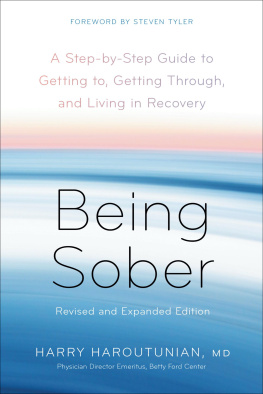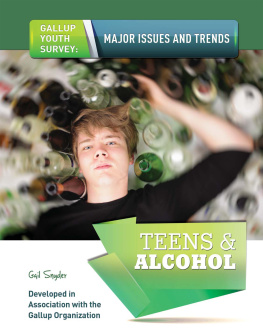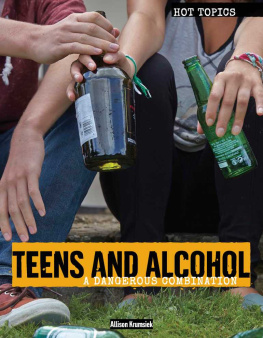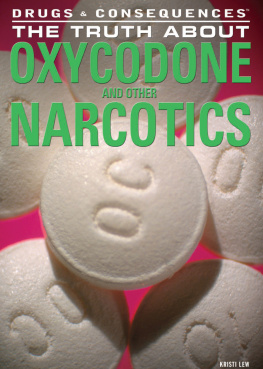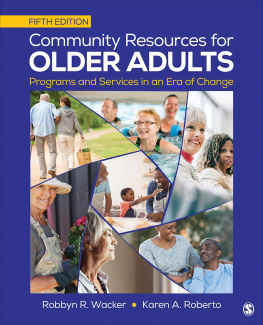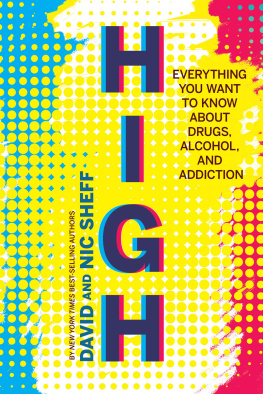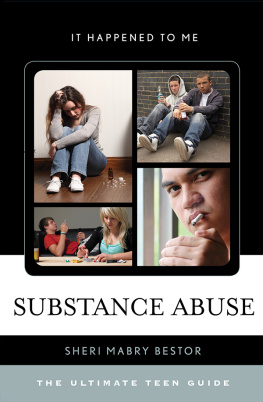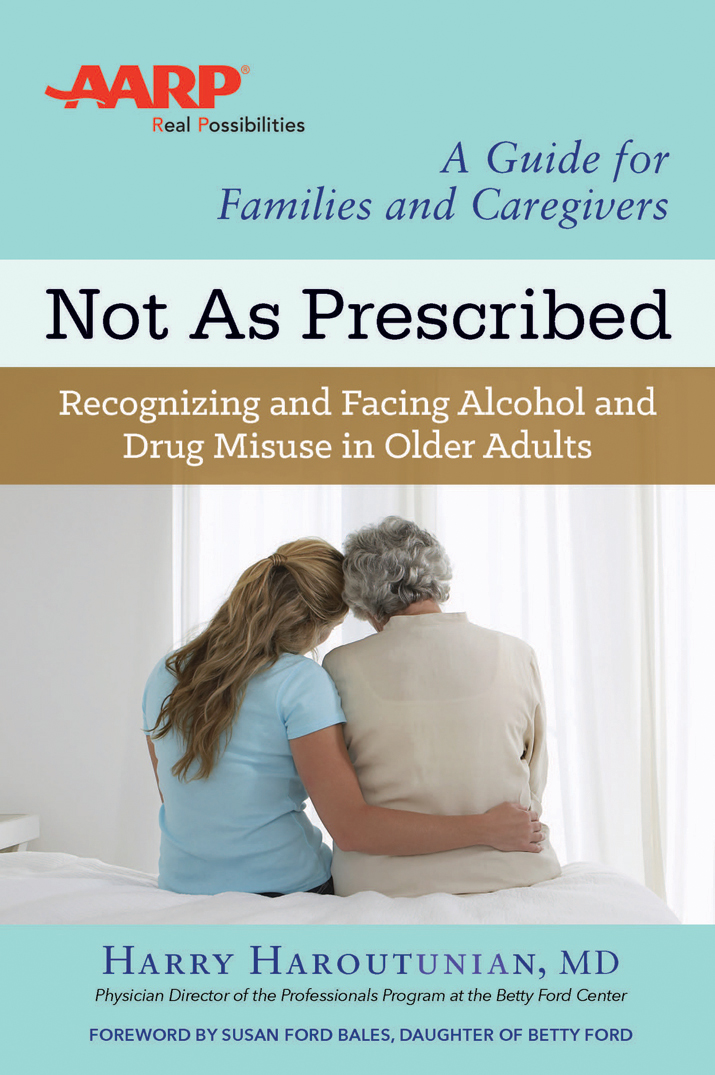


Hazelden Publishing
Center City, Minnesota 55012
hazelden.org/bookstore
2016 by Harry Haroutunian
All rights reserved. Published 2016.
No part of this publication may be reproduced, stored in a retrieval system, or transmitted in any form or by any means, electronic, mechanical, photocopying, recording, scanning, or otherwise, except as permitted under Section 107 or 108 of the 1976 United States Copyright Act, without the prior written permission of the publisher. Failure to comply with these terms may expose you to legal action and damages for copyright infringement.
Library of Congress Cataloging-in-Publication Data
Names: Haroutunian, Harry L., author.
Title: Not as prescribed: recognizing and facing alcohol and drug misuse in older adults / Harry Haroutunian, MD; foreword by Susan Ford Bales, daughter of Betty Ford.
Description: Center City, MN: Hazelden, 2016.
Identifiers: LCCN 2015047061 (print) | LCCN 2016005186 (ebook) | ISBN 9781616496289 (e-book)
Subjects: LCSH: Older peopleAlcohol useUnited States. | Older peopleDrug useUnited States. | Alcoholism counselingUnited States. | Drug addictionTreatmentUnited States. | BISAC: SELF-HELP / Substance Abuse & Addictions / General.
Classification: LCC HV5138 .H37 2016 (print) | LCC HV5138 (ebook) | DDC 362.29084/60973dc23
LC record available at http://lccn.loc.gov/2015047061
Editors notes
The names, details, and circumstances may have been changed to protect the privacy of those mentioned in this publication.
This publication is not intended as a substitute for the advice of health care professionals.
Limit of Liability/Disclaimer of Warranty
While AARP, the publisher, and the author have used their best efforts in preparing this book, they make no representations or warranties with respect to the accuracy or completeness of the contents of this book and specifically disclaim any implied warranties of merchantability or fitness for a particular purpose. No warranty may be created or extended by sales representatives or written sales materials. The advice and strategies contained herein may not be suitable for your situation. You should consult with a professional where appropriate. AARP, the publisher, and the author shall not be liable for any loss of profit or any other commercial damages, including but not limited to special, incidental, consequential, or other damages. The fact that an organization or website is referred to in this work as a citation and/or a potential source of further information does not mean that AARP, the publisher, and the author endorse the information the organization or website may provide or recommendations it may make. The recommendations and opinions expressed herein are those of the author and do not necessarily reflect the views of AARP. Further, readers should be aware that websites listed in this work may have changed or disappeared between when this work was written and when it is read.
AARP is a registered trademark.
20 19 18 17 16 1 2 3 4 5 6
Cover design: Theresa Jaeger Gedig; Interior design: Terri Kinne; Typesetting: Bookmobile Design & Digital Publisher Services; Developmental editor: Sid Farrar; Production editor: Heather Silsbee; and Director of AARP Books: Jodi Lipson
To my mother,
Antoinette (Grandma Toni) Haroutunian
Table of Contents
Guide
Contents
Just seven days shy of my mothers sixtieth birthday, the Ford family held an intervention. Betty Fordmy mother, a wife, former First Lady, breast cancer survivor, and a woman with a long list of accomplishmentswas also an addict. And her addiction was overshadowing anything and everything she had ever done well in her life. And it was ruining mine.
The youngest of four children, I lived closest to our parents home in California. Our dadPresident Gerald Fordtraveled a lot, so I spent the most time with Mom during the most destructive phase of her addiction, when she stumbled, slurred her words, fell asleep midsentence, isolated herself from friends, and didnt bother to dress until late in the afternoon. Still, I was clueless about how many pills she was taking. And the doctors just kept prescribing them.
My beautiful mother, who had been a graceful dancer in her youth, a devoted and loving wife, an involved and caring parent, and a gracious hostess to world leaders visiting the White House, was now lounging around her new home in the desert, demanding that we pour stronger drinks. Betty Ford was addicted to alcohol, sedative-hypnotics, and prescription painkillers, which she had started using during her bout with breast cancer and to ease the pain of a pinched nerve in her neck. Mom and Dad grew up in the era of cocktails before dinner, and the combination of alcohol and prescription drugs was not 2 + 2 = 4.
In 1978, the year of our intervention, none of us in the family even knew what an intervention was. We were hardly familiar with the concept of addiction. And we certainly didnt fully comprehend that it was a family diseasethat all of us kids and our dad were affected as well. We knew something was wrong, and we knew we didnt like how hurt and frustrated we felt by her behavior. But even with a former head of state on our team, we were clueless about how to stop Mom from what seemed like a clear path of self-destruction. She didnt listen to reason. She didnt see what we saw. As she wrote in her autobiography, Betty: A Glad Awakening:
My makeup wasnt smeared, I wasnt disheveled, I behaved politely, and I never finished off a bottle, so how could I be alcoholic? And I wasnt on heroin or cocaine, the medicines I tookthe sleeping pills, the pain pills, the relaxer pills, the pills to counteract the side effects of other pillshad been prescribed by doctors, so how could I be a drug addict?
Almost forty years later, these words still echo through the hearts and minds of older adults who are taking mood-altering prescription medications or a toxic combination of prescribed drugs; family members are still at a loss for what to do; and doctors are still prescribing addictive medications in an effort to help their patients. Not As Prescribed is a valiant effort at helping concerned loved ones and caregivers of older adults understand the dynamics behind these issues, why they havent gone away, and why they are only getting worse.
During the chaos of my moms addiction, I was scared, I was angry, and when I saw a chance for help, I took it. I just happened to be working with a doctor who was also in recovery from alcoholismand who conducted interventions. He agreed to help us. I told my dad that Mom needed help and that we needed to hold an intervention. He agreed. Each of us in the family participatedeven my brother Jack, who had pretty much given up on Mom. We each expressed our love and support, voiced how wed been hurt by her behavior, and asked her to get help. She agreed, reluctantly, and entered the Naval Hospital in Long Beach, California, for addiction treatment.
Before the epidemic that prescription painkiller abuse is today, before women felt safe getting help for the disease of addiction, and before the specialized treatment and recovery needs of older adults were considered relevant, Betty Ford boldly stepped into the world of treatment and recovery. Our intervention was a successwe got Mom into treatment, and she embraced recovery with a vengeance. But she didnt go with bells on her toes. In fact, there was a little kicking and screaming, at least in the beginning.
Next page

